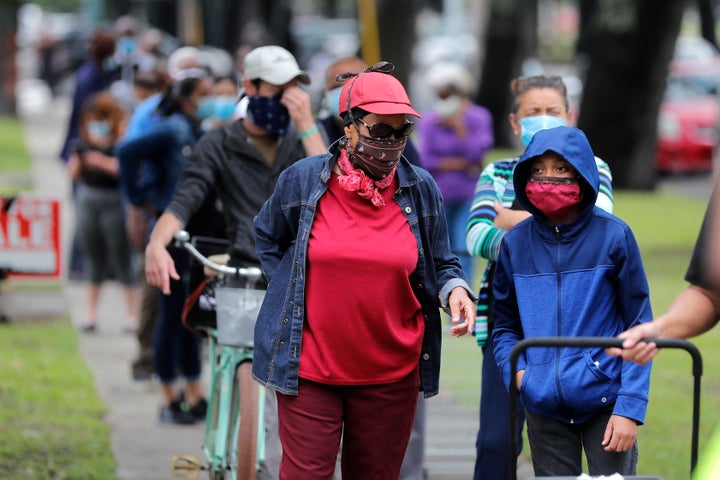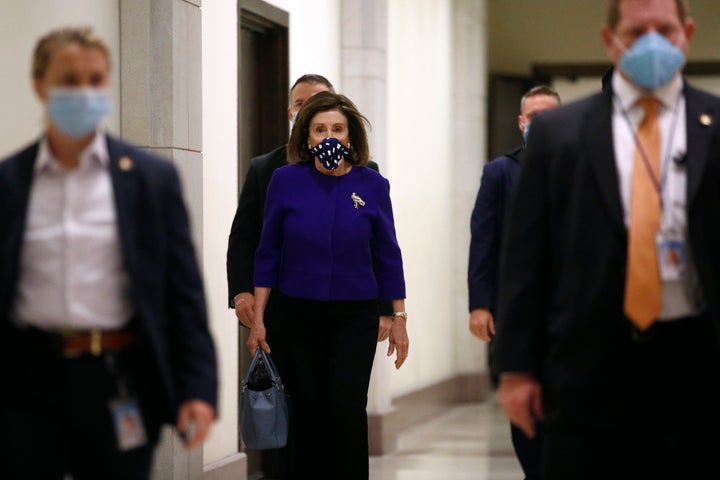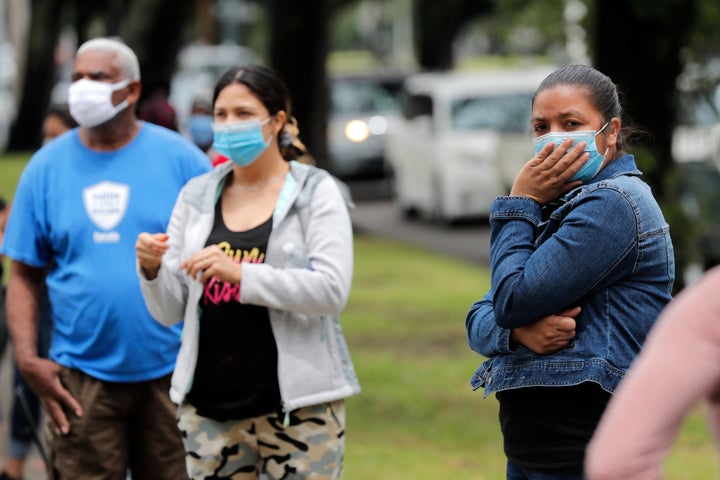Americans are in need of cash.
In March, congressional leaders and top White House officials negotiated a coronavirus relief package that included up to $1,200 in direct cash payments to most Americans and a $600 weekly increase in unemployment benefits for four months.
But they completely left out a preexisting program that’s meant to give cash assistance to America’s most vulnerable. Temporary Assistance For Needy Families, or TANF, has played no role in the government’s coronavirus economic relief efforts, and Congress didn’t touch the program in its package of emergency funding.
“We are starting from scratch and we completely glossed over this other program where this was the intention: to provide cash aid to families with kids,” said Luke Shaefer, a poverty and social welfare expert at the University of Michigan. “How it got just missed is just pretty astounding.”
The program is still operating in states. In early April, officials in Columbus, Ohio, made $1.5 million available through TANF, offering $500 checks to families making up to 200% of the federal poverty level — about $43,000 annually for a family of three. It was gone in one day.
In Michigan, applications for TANF have almost doubled. Same with California. In Washington state, the week before the pandemic hit, there were about 1,100 applications. The week of March 16, when Gov. Jay Inslee (D) called for a temporary shutdown of nonessential businesses, there were about 3,000.
Once idealized as one of Congress’ great compromises to alleviate poverty, TANF’s effectiveness has been on the decline since the program was established in the 1996 welfare reform bill. When it began, for every 100 families in poverty, 68 received benefits. In 2018, only 22 families out of 100 in poverty were getting aid.
For years, states have diverted the money given to them through federal block grants to other programs, from “crisis pregnancy centers” to prekindergarten and Head Start programs, justifying the funding transfers as ways to help job creation and encourage two-parent family life. An audit of Mississippi’s TANF program released Monday found the state’s funds went toward sponsoring college basketball tournaments and paying former NFL star Brett Favre for speeches that never happened.
On average, states spend as little as 20 cents of every TANF dollar on cash assistance. And when the economy sours, as it has during the pandemic, states have even less money to dole out to people who need it.
As far as Congress is concerned, TANF isn’t worth touching anymore.
“TANF really is dead as a chapter in our book.”
- Luke Shaefer, University of Michigan public policy expert
House Democrats attempted to remove TANF’s work requirements in April, but dropped their demand in negotiations with the White House. A senior Democratic aide close to the talks said House priorities now are to extend unemployment benefits; boost funding for the Supplemental Nutrition Assistance Program, or food stamps; provide refundable tax credits; supply broadband and water utility relief; and fund another check for all Americans.
“TANF’s distribution of dollars among states is not ideal,” a senior House Democratic aide familiar with leadership’s thinking said. “SNAP is a much more universal low-income program. SNAP will be a priority again in the next bill.”
In the Senate, Sen. Ron Wyden (D-Ore.), the top Democrat on the Finance Committee who was behind the unemployment insurance expansion, plans to propose a whole new program to get financial assistance to low-income Americans, separate from TANF altogether. The senator this week is expected to announce a $5 billion grant for states to give cash assistance and other benefits to those at 200% of the poverty line and below.
“The fact that this is the biggest response to an economic crisis — it ended up being $2 trillion — and we didn’t include anything for TANF ... TANF really is dead as a chapter in our book,” Shaefer said. Still, he noted, the pandemic is forcing more people into poverty while states have less money to help.
“The crux is, what happens when we run out of money?” Shaefer asked.

TANF hasn’t responded well in recessions. But the need is there.
During the last major economic crisis in 2009, TANF got a boost: The Recovery Act created a $5 billion TANF emergency fund, which expired in 2010, to help states handle increasing demands for help. The program was complicated and riddled with problems.
States largely didn’t target their neediest residents for the funds. Still, every state except Wyoming took the federal funding.
As welfare programs go, TANF has a substantially smaller role than programs like SNAP and unemployment insurance in an economic crisis.
It’s also less advertised. Unlike unemployment insurance and food stamps, TANF has “faded from the public imagination,” Kathryn Edin, a Princeton University sociologist, said.
“TANF is just not on the radar at all,” Edin said, reflecting on a congressional hearing she attended on anti-poverty programs in early March. “When we talk to people living on no cash income, it doesn’t even occur to them to apply to TANF. People who were on the verge of eviction and homelessness had never heard of the program.”
That’s in stark contrast to TANF’s predecessor, Aid to Families with Dependent Children. The AFDC program was effective at providing aid, but it was criticized for discouraging recipients from working.
TANF was created with support from Democrats and Republicans with the aim of putting people into jobs, keeping kids with their families, and encouraging two-parent households. To do that, the 1996 Welfare Reform bill made three big changes to AFDC. It instituted work requirements, limited how long people could receive aid, and changed federal funding into a block grant — a lump sum given to states to allocate under certain, albeit loose, conditions.
“When we talk to people living on no cash income, it doesn’t even occur to them to apply to TANF. People who were on the verge of eviction and homelessness had never heard of the program.”
- Kathryn Edin, Princeton University sociologist
The TANF work rules didn’t pan out in the 2000s, when jobs were hard to find. And the shortcomings are especially stark during the coronavirus pandemic, when work isn’t an option for many.
“There were some naive intentions that the ’90s economy would last forever and you could really get people into the workforce, and that work would sustain them,” Edin said. “But after 2000 that fell apart.”
The program’s core funding hasn’t been adjusted for inflation in decades. States have been shedding TANF recipients, even if poverty levels haven’t improved, and they’ve been using the money for other programs. Schaefer called it “free money” for the states.
And now, when they need it during the pandemic, states don’t have the money to plow back into TANF.
Congress doesn’t see TANF as a pandemic response
James Ziliak, who runs the University of Kentucky’s Center for Poverty Research, said Congress could step in. The federal government could waive TANF’s work requirements and time limits during the pandemic, and tailor a new version of the 2009 TANF emergency fund to actually get checks into people’s hands.
TANF “has the potential to be a cash program,” Ziliak said, unlike SNAP and other welfare programs. “Work is not really possible right now, so cash is the thing. Households don’t have access to cash — they are getting a stimulus payment, which is one and done, and that could be delayed. ... It could reach a very important and frequently left behind population.”
So far, that hasn’t been Congress’ approach. The $2 trillion coronavirus stimulus package that was passed last month included the direct cash payments to Americans as well as the unemployment expansion. Neither directly target the poor.

“The stimulus check was more about the economy than about the needy,” Edin said. “If you are trying to get money to the needy that is a highly inefficient way of doing that.”
There’s also an understanding among poverty experts that while TANF is far from an ideal model, it already exists and is specifically aimed at helping the neediest.
A child allowance system, or basic income ― popular ideas among anti-poverty experts during the pandemic ― are unlikely to provide immediate relief.
“The major advantage of the TANF program is that it adjusts as people’s needs adjust,” Edin said. “As long as you are below a threshold of income you have a base. It’s not a very good base … but the alternative is no cash at all.”
There’s no appetite in either party to address the program’s shortcomings.
A big compromise that aged poorly
The 1996 welfare reform bill was a compromise between President Bill Clinton’s administration and conservative House Speaker Newt Gingrich. Once idealized as a program that would fundamentally transform American society, TANF now is mostly forgotten history.
Some prominent Democratic policy advisers behind the program are still major players in today’s politics. One of them, Bruce Reed, is a close confidant of presumptive Democratic presidential nominee Joe Biden and traveled with him on the campaign trail. The Biden campaign declined a request for an interview with Reed.
In 2016, at a Brookings event with Gingrich, Reed praised the welfare reform bill and funding structure. Pressed, he said he was “disappointed” in how states were handling the funding and called for adjustments for inflation and population changes. But he wasn’t critical of the program as a whole. For Gingrich and Reed, TANF remained a great legislative accomplishment, although Gingrich said he wouldn’t focus on the program if he were to address welfare then.
“One lesson of welfare reform ... it may be easier to get bipartisan agreement with big bold ideas than timid small ones,” Reed said at the Brookings event.
It’s the kind of thinking that Biden himself has been espousing on the campaign trail. “Compromise isn’t a dirty word,” the former vice president likes to say.

But now, two decades into TANF, the program lies unmaintained in a time of rising poverty and need. Although Republicans traditionally resist direct cash assistance, they supported the coronavirus relief payments and will again get the chance with Wyden’s idea of providing funding for states to distribute cash payments.
But TANF won’t be on the table.
“The bigger issue is that cash assistance is often a non-starter for Republicans,” said Emily Rampone, a policy adviser on the Senate Budget Committee who works under Sen. Bernie Sanders’ (I-Vt.) minority leadership.
Rampone pointed to Sanders’ proposal to provide $2,000 monthly cash payments through the coronavirus pandemic.
“That would be greater than any family could receive under TANF and negate a lot of the issues with TANF such as strict income limits, work requirements, and state matching funds,” Rampone said.
“Sadly,” Ziliak said, “I think Congress thinks this is a program on autopilot.”

- Stay up to date with our live blog as we cover the COVID-19 pandemic
- What happens if we end social distancing too soon?
- What you need to know about face masks right now
- Will there be a second stimulus check?
- Lost your job due to coronavirus? Here’s what you need to know.
- Why it takes so long to make a coronavirus vaccine
- Parenting during the coronavirus crisis?
- The HuffPost guide to working from home
- What coronavirus questions are on your mind right now? We want to help you find answers.
- Everyone deserves accurate information about COVID-19. Support journalism without a paywall — and keep it free for everyone — by becoming a HuffPost member today.

